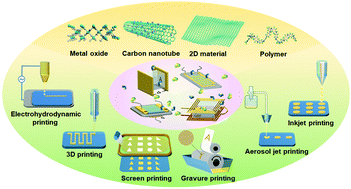当前位置:
X-MOL 学术
›
Chem. Soc. Rev.
›
论文详情
Our official English website, www.x-mol.net, welcomes your feedback! (Note: you will need to create a separate account there.)
Printed gas sensors.
Chemical Society Reviews ( IF 46.2 ) Pub Date : 2020-02-17 , DOI: 10.1039/c9cs00459a Jie Dai 1 , Osarenkhoe Ogbeide 2 , Nasiruddin Macadam 2 , Qian Sun 3 , Wenbei Yu 4 , Yu Li 5 , Bao-Lian Su 5 , Tawfique Hasan 2 , Xiao Huang 1 , Wei Huang 3
Chemical Society Reviews ( IF 46.2 ) Pub Date : 2020-02-17 , DOI: 10.1039/c9cs00459a Jie Dai 1 , Osarenkhoe Ogbeide 2 , Nasiruddin Macadam 2 , Qian Sun 3 , Wenbei Yu 4 , Yu Li 5 , Bao-Lian Su 5 , Tawfique Hasan 2 , Xiao Huang 1 , Wei Huang 3
Affiliation

|
The rapid development of the Internet of Things (IoT)-enabled applications and connected automation are increasingly making sensing technologies the heart of future intelligent systems. The potential applications have wide-ranging implications, from industrial manufacturing and chemical process control to agriculture and nature conservation, and even to personal health monitoring, smart cities, and national defence. Devices that can detect trace amounts of analyte gases represent the most ubiquitous of these sensor platforms. In particular, the advent of nanostructured organic and inorganic materials has significantly transformed this field. Highly sensitive, selective, and portable sensing devices are now possible due to the large surface to volume ratios, favorable transport properties and tunable surface chemistry of the sensing materials. Here, we present a review on the recent development of printed gas sensors. We first introduce the state-of-the-art printing techniques, and then describe a variety of gas sensing materials including metal oxides, conducting polymers, carbon nanotubes and two-dimensional (2D) materials. Particular emphases are given to the working principles of the printing techniques and sensing mechanisms of the different material systems. Strategies that can improve sensor performance via materials design and device fabrication are discussed. Finally, we summarize the current challenges and present our perspectives in opportunities in the future development of printed gas sensors.
中文翻译:

印刷气体传感器。
支持物联网(IoT)的应用程序和互联自动化的快速发展,使传感技术日益成为未来智能系统的核心。潜在的应用具有广泛的意义,从工业制造和化学过程控制到农业和自然保护,甚至到个人健康监控,智慧城市和国防。可以检测痕量分析物气体的设备代表了这些传感器平台中最普遍的一种。特别地,纳米结构的有机和无机材料的出现极大地改变了这一领域。由于较大的表面体积比,良好的传输性能以及传感材料的可调表面化学性质,现在可以实现高度灵敏,选择性和便携式的传感设备。这里,我们对印刷气体传感器的最新发展进行回顾。我们首先介绍最先进的打印技术,然后介绍各种气体感应材料,包括金属氧化物,导电聚合物,碳纳米管和二维(2D)材料。特别强调了印刷技术的工作原理和不同材料系统的传感机制。讨论了可以通过材料设计和设备制造来提高传感器性能的策略。最后,我们总结了当前的挑战,并就印刷气体传感器的未来发展机会提出了自己的看法。然后介绍了各种气体传感材料,包括金属氧化物,导电聚合物,碳纳米管和二维(2D)材料。特别强调了印刷技术的工作原理以及不同材料系统的传感机制。讨论了可以通过材料设计和设备制造来提高传感器性能的策略。最后,我们总结了当前的挑战,并就印刷气体传感器的未来发展机会提出了自己的看法。然后介绍了各种气体传感材料,包括金属氧化物,导电聚合物,碳纳米管和二维(2D)材料。特别强调了印刷技术的工作原理以及不同材料系统的传感机制。讨论了可以通过材料设计和设备制造来提高传感器性能的策略。最后,我们总结了当前的挑战,并就印刷气体传感器的未来发展机遇提出了自己的看法。讨论了可以通过材料设计和设备制造来提高传感器性能的策略。最后,我们总结了当前的挑战,并就印刷气体传感器的未来发展机会提出了自己的看法。讨论了可以通过材料设计和设备制造来提高传感器性能的策略。最后,我们总结了当前的挑战,并就印刷气体传感器的未来发展机会提出了自己的看法。
更新日期:2020-03-24
中文翻译:

印刷气体传感器。
支持物联网(IoT)的应用程序和互联自动化的快速发展,使传感技术日益成为未来智能系统的核心。潜在的应用具有广泛的意义,从工业制造和化学过程控制到农业和自然保护,甚至到个人健康监控,智慧城市和国防。可以检测痕量分析物气体的设备代表了这些传感器平台中最普遍的一种。特别地,纳米结构的有机和无机材料的出现极大地改变了这一领域。由于较大的表面体积比,良好的传输性能以及传感材料的可调表面化学性质,现在可以实现高度灵敏,选择性和便携式的传感设备。这里,我们对印刷气体传感器的最新发展进行回顾。我们首先介绍最先进的打印技术,然后介绍各种气体感应材料,包括金属氧化物,导电聚合物,碳纳米管和二维(2D)材料。特别强调了印刷技术的工作原理和不同材料系统的传感机制。讨论了可以通过材料设计和设备制造来提高传感器性能的策略。最后,我们总结了当前的挑战,并就印刷气体传感器的未来发展机会提出了自己的看法。然后介绍了各种气体传感材料,包括金属氧化物,导电聚合物,碳纳米管和二维(2D)材料。特别强调了印刷技术的工作原理以及不同材料系统的传感机制。讨论了可以通过材料设计和设备制造来提高传感器性能的策略。最后,我们总结了当前的挑战,并就印刷气体传感器的未来发展机会提出了自己的看法。然后介绍了各种气体传感材料,包括金属氧化物,导电聚合物,碳纳米管和二维(2D)材料。特别强调了印刷技术的工作原理以及不同材料系统的传感机制。讨论了可以通过材料设计和设备制造来提高传感器性能的策略。最后,我们总结了当前的挑战,并就印刷气体传感器的未来发展机遇提出了自己的看法。讨论了可以通过材料设计和设备制造来提高传感器性能的策略。最后,我们总结了当前的挑战,并就印刷气体传感器的未来发展机会提出了自己的看法。讨论了可以通过材料设计和设备制造来提高传感器性能的策略。最后,我们总结了当前的挑战,并就印刷气体传感器的未来发展机会提出了自己的看法。



























 京公网安备 11010802027423号
京公网安备 11010802027423号